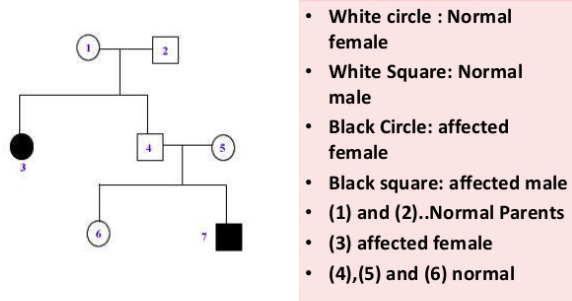Genetic Inheritance
Mendel
Our understanding of inheritance began with the work of Gregor Mendel.
He bred pea plants, and later found that when he crossed pink pea plants with white pea plants all the offspring had pink flowers. He also found that certain characteristics can skip a generation, then reappear.
Key Terms
Monohybrid Inheritance
Punnett squares can be used to look at combinations of genetic crosses in single genes.
This would show the possible combination of offspring that can be produced - you would be able the calculate the probability of obtaining a certain characteristic.
Example 1
Whether someone has hairy ears or non-hairy ears is controlled by a single gene with 2 alleles: hairy and non-hairy.
- The hairy allele is dominant and is shown as H
- The non-hairy allele is recessive and is shown as h
If someone with hairy ears (Hh) reproduces with someone with non-hairy ears (hh), here is the punnett square to represent this information:
Direct Proportion: half of the offspring would have hairy ears (Hh), and the other half will not have hairy ears (hh).
__Probability: __
- The probability of offspring being Hh is 50%
- The probability of offspring being hh is 50%
__Ratio: __The ratio of the genotypes HH:Hh is 1:1
Example 2
Whether someone has sickle cell anaemia is determined by a single gene with 2 alleles: S and s.
If someone has a single allele of ‘s’, they will be a carrier. If someone has two alleles of ‘ss’, they will have sickle cell anaemia. If someone has two alleles of ‘SS’, they will be safe from the disease.
If two carriers of sickle cell anaemia have a child together, here is the punnett square to represent this information:
Direct Proportion: a quarter of the offspring will be safe from sickle cell anaemia (SS), a quarter of the offspring will have sickle cell anaemia (ss), and half the offspring will be carriers (Ss).
__Probability: __
- The probability of offspring being Ss is 50%
- The probability of offspring being SS is 25%
- The probability of offspring being ss is 25%
__Ratio: __The ratio of the genotypes Ss:SS:ss is 2:1:1
This is another type of diagram that shows the genotype and phenotype:
This is a family pedigree which allows you to determine the phenotype within a family. This family pedigree shows the information of 3 generations. The key on the right is used to determine whether the individual is affected or not.
- How many chromosomes does a fertilised egg have?
- 46
- Where are chromosomes found?
- Nucleus
Explanation: Inside the nucleus - What is the genotype of someone that suffers from sickle cell anaemia?
- ss


